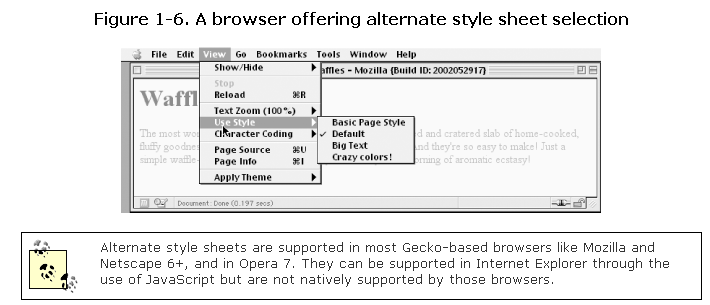css指令,兼容,注釋,selector
編輯:CSS詳解
 還可以通過將title設定為相同的value來分組:
還可以通過將title設定為相同的value來分組:<link rel="stylesheet" type="text/CSS"
href="sheet1.CSS" title="Default" media="screen" />
<link rel="stylesheet" type="text/CSS"
href="print-sheet1.CSS" title="Default" media="print" />
<link rel="alternate stylesheet" type="text/CSS"
href="bigtext.CSS" title="Big Text" media="screen" />
<link rel="alternate stylesheet" type="text/CSS"
href="print-bigtext.CSS" title="Big Text" media="print" />
上面的表述意為:CSS被title分為兩組,default和Big Text。又每一組又被分為print和screen。如果有多個link元素,那麼只有rel等於stylesheet的link可用。如果可用的link有多個,就會將它們同時作用於Html文檔,如下: <link rel="stylesheet" type="text/css" href="basic.CSS" /> <link rel="stylesheet" type="text/css" href="splash.CSS" /> 1.2.2 style style是引入style sheet最通用的方式。 <style type="text/CSS"> type:style總是使用type屬性,當使用css時,type的值是“text/CSS”。 Media:與link中一樣。 style以<style type="text/CSS">開頭,以</style>結束,中間是多個styles。這些styles或者指向style sheet文檔,或者以內嵌的方式表達。Style元素可以包含多個styles,也可以通過@import指令引入多個指向外部style sheet的鏈接。 1.2.3 @import指令 用法:
<style type="text/CSS">@import url(styles.CSS); /* @import comes first */ @import url(blueworld.CSS); @import url(zany.CSS); h1 {color: gray;} </style> 可見其作用類似link, l 通知浏覽器將外部style sheet載入。 l 並且可以載入多個style sheet。 區別是 l 位置與語法不同。 @import被包含在style元素中,並且必須在其他CSS規則之前。 l 每一個import的style sheet都會被使用,沒有替代規則。 相對於link的media屬性,import有: @import url(sheet2.CSS) all; @import url(blueworld.CSS) screen; @import url(zany.CSS) projection, print; @import的重要用途: 在導入的某個style sheet A中,A需要也使用外部的style sheet,這時link元素顯然無用。比如CSS文檔中,是不可能出現link元素的,這時使用@import,如下: @import url(http://example.org/library/layout.CSS); @import url(basic-text.CSS); @import url(printer.CSS) print; body {color: red;} h1 {color: blue;} 1.3 與老版本浏覽器的兼容問題 浏覽器對不能識別的tag一律忽略。但是如果浏覽器不能識別style元素,style會以普通文本的形式出現在網頁的最上面。解決方案:在style裡面加上注釋符號,這樣舊版本的浏覽器不會以文本方式顯示,新版本浏覽器可以正確使用style元素。具體如下: <style type="text/CSS"><!-- @import url(sheet2.CSS); h1 {color: maroon;} body {background: yellow;} --></style> 1.4 CSS中的注釋 CSS的注釋類似c: /* This is a CSS1 comment */ Comments can span multiple lines, just as in C++: /* This is a CSS1 comment, and it can be several lines long without any problem whatsoever. */ 但是注意:CSS的注釋不能被嵌套。 1.5內聯風格inline style 將style放到Html元素描述的地方,就是inline style <p style="color: gray;">The most wonderful of all breakfast foods is the waffle--a ridged and cratered slab of home-cooked, fluffy goodness... </p> 這個style屬性是一個新屬性,可以用到出現body元素中的所有元素上。 可以看到style的值是一個字符串,使用和CSS一樣的語法。 但是這個字符串只能是一個風格聲明塊declaration block。不能將@import和CSS 規則放到這個字符串中。就是說只能放CSS文檔中出現在花括號中的文本。 注意:inline style不被推薦使用,在xHtml1.1中inline style是反對的 deprecated。因為,它顯示違背數據和顯示分離的原則。這個原則也是使用CSS的 原因。 2 selector CSS核心的特點是將規則應用到元素集上的能力。 CSS2規范種關於selector的部分, http://www.w3.org/TR/REC-CSS2/selector.Html css的模式匹配pattern matching規則(CSS規范,地址如上): Pattern Meaning Described in section * Matches any element. Universal selector E Matches any E element (i.e., an element of type E). Type selectors E F Matches any F element that is a descendant of an E element. Descendant selectors E > F Matches any F element that is a child of an element E. Child selectors E:first-child Matches element E when E is the first child of its parent. The :first-child pseudo-class E:link
E:visited Matches element E if E is the source anchor of a hyperlink of which the target is not yet visited (:link) or already visited (:visited). The link pseudo-classes E:active
E:hover
E:focus Matches E during certain user actions. The dynamic pseudo-classes E:lang(c) Matches element of type E if it is in (human) language c (the document language specifIEs how language is determined). The :lang() pseudo-class E + F Matches any F element immediately preceded by an element E. Adjacent selectors E[foo] Matches any E element with the "foo" attribute set (whatever the value). Attribute selectors E[foo="warning"] Matches any E element whose "foo" attribute value is exactly equal to "warning". Attribute selectors E[foo~="warning"] Matches any E element whose "foo" attribute value is a list of space-separated values, one of which is exactly equal to "warning". Attribute selectors E[lang|="en"] Matches any E element whose "lang" attribute has a hyphen-separated list of values beginning (from the left) with "en". Attribute selectors DIV.warning Html only. The same as DIV[class~="warning"]. Class selectors E#myid Matches any E element ID equal to "myid". ID selectors
小編推薦
熱門推薦